
Gallery Photographers
Partner
Artists-in-Residence
If you are unable to visit our gallery and would like to purchase photographs from this preview or others in the gallery, please contact the gallery and call 585-271-2540.
Peter's and Gallery Picks of the Show
Holiday Show 2014
December 2 - December 23, 2014
Peter Marr and Gallery partners have made a selection of their favorites
from the Featured and Guest Photographers in the exhibit.
click here to return to the details of the exhibit
All images copyright by the individual photographers
Peter's Picks of the Exhibit
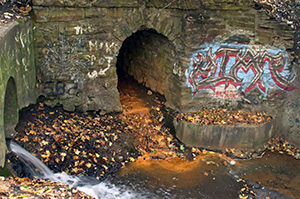 | Drainage by Archie C. Curry
Meaningful art is mind changing, and here, the author has magically
transformed the confluence of two culverts into a visionary image that
has both philosophical and psychological implications, as well as
provoking visual concern. There is a mood and drama in this scene that
is truly thought-provoking. The soft lighting is spectacular, resulting
in a striking color palette of autumnal hues, that left what could be a
dreary scene into one that has a warmth and glow that is both reassuring
and satisfying, especially considering the subject matter. To appreciate
the hidden beauty of this setting, the viewer has to look beyond the
facade that is essentially a creatively recorded documentary of social
deprivation and urban squalor. These two drains are sewers that are
discharging waste material into a polluted area, a scenario that has
probably existed for many years. This is an environ that few have
visited or are even aware of, and there are further questions that one
might raise, namely, what are upstream of these two culverts, and what
is downstream? The senseless addition of graffiti is an unnecessary
distraction, for it mars the lovely brick and stonework and support
structure of the elegant archway of the culvert. The silver lining may
be that such desecration may call attention to this polluted space, and
result in some sort of clean-up, that will at least take care of the
health hazards and pollution problems. The artist is much to be admired
for taking such a meaningful photograph, which not only highlights an
area of urban concern, but he has done it in such an artistic way, that
the resulting print is memorable and uplifting.
Peter A. Marr
|
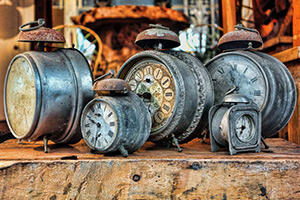 |
The Old Timers by Scott Matyjaszek
No exhibition at the Image City would be complete without the addition
of the inspired work of Scott, whose unbounded creativity is a product
of his inner conviction. Here, in a series of 3-dimensional “Photo
Sculptures,” the highlight is an incredible cathedral composition, but I
decided to comment further on an equally awesome piece, namely, The
Old Timers
largely because I was fascinated by the human element that I was very
much aware of. On a vintage wooden shelf there is an array of antique
clocks, who are more renowned for their historical value than for their
ability to tell the time. The lighting exquisitely reveals an extensive
range of muted and delicate color hues, together with a variety of
surface textures that are a most compelling visual treat. It may be
difficult to imagine what these clocks looked like in their prime, or
how well they kept the time, but what is overwhelmingly apparent to me,
is that these clocks are indeed a family, representing at least 3
generations. The central clock is very much the father, strikingly
exemplified by the colorful facial feature, and the ornate, decorative
detail on the body. His wife, appropriately for the era that they
originated from, stands quietly behind him, having ornamentation that is
much more subdued. The eldest son, who is proudly placed ahead of his
father, reveals a body frame and sterner visage appropriate for a more
modern generation, certainly not typical of his parents. The youngest
sibling, almost certainly feminine because of her square face and back,
clean cap, and more slender body. She exudes a more modern approach to
life, and is definitely “with it” for she has everything on the ground,
not needing the feet that the rest of her family has. It is important to
note that the young girl is facing away from the other clocks, possibly
indicating a complete disdain for the rest of the family. The clock on
the far left is certainly the patriarch, although there is some doubt in
this conclusion, for although the face has aged beyond recognition, the
body is more shiny and featureless with a cap that has more than an
ample covering of rust. Of course, it is possible that severe ailments
and repeated hospitalization could have contributed to the loss of
features and character. Although this is a light-hearted interpretation
of this exceptional piece of art, I do sincerely believe that these
clocks have a life and character of their own, inanimate as they are. I
hope that every viewer who has the good fortune to see this superb
composition will take the time to study it and come up with their own
ideas as to what they really see or imagine. One final thought, I just
hope that the collector who purchases these antique masterpieces, will
buy all 5 of them, so that the family can stay together for many years
to come.
Peter A. Marr
|
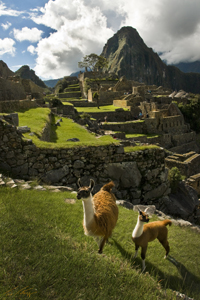 |
Machu Picchu, Llama and Baby by Ted Tatarzyn
Ted’s love for photography and nature is very much evidenced by his
superb series of prints on display in the Image Gallery. I am honored to
have been a friend and colleague of his for many years, and I have
always admired his outstanding artistic talent for creating breathtaking
images of a wide variety of diverse subject material, often from remote
and challenging areas on every continent in the world. His energy,
enthusiasm and dedication are boundless and exhilarating, putting him at
the forefront of some of the finest nature photographers in the world.
Untold thousands of photographs have been taken of Machu Picchu, but
Ted’s print in this exhibition ranks right up there with the very best.
Obviously, this spectacular image benefits enormously from the
incredible presence in the foreground of the llama and her baby. This
was definitely no accident. Careful planning of everything from the time
of day, the lighting, camera position, and of course animal activity and
positioning, all went into the decisive moment when the picture was
taken. In admiring this print, one is immediately captivated by the
gorgeous backlighting, which lovingly reveals many of the architectural
wonders of this ancient city, from the terraces and housing structures,
all the way to the dramatic dry stone walls. This illumination and
fill-light from the bright surrounds, brilliantly highlights all of the
important details in the two animals, from the massive woolly coat of
the mother and smoother fine wool structure of the baby llama, all the
way to the prominent erect ears of both of them. The color harmony is
exquisite, from the sumptuous vivid greens and saturated browns, all set
against a blue sky, where fleeting clouds dance across the background
expanse. Even the llamas in there rich brown coats blend in beautifully
with their surrounds. I love the solitary, resplendent tree set
imaginatively against the impressive mountain peak, poignantly both very
much alive, sadly overlooking the remains of a once great city that was
vibrant and magnificent for only a little more than a century. The two
llamas are little changed from their brethren who roamed these hillsides
in the 15th century and well beyond. These important animals are now
just onlookers to what is now left of an extraordinary civilization. Ted
has artistically and inspiringly captured a visionary image for all to
see and marvel at.
Peter A. Marr
|
|
|
Algonquin Dock by Charles Vaughn
This evocative and artistic image, beautifully illustrates that the
subject matter is for contemplation and a source of inspiration, as well
as expressing the author’s own thoughts and feelings. There is a
reverence and gracefulness that represents both tranquility and
strength, where the latter is restorative, and the overall effect is
magical and sublime. Here, there is an atmosphere and heightened
awareness that results in both drama and excitement, and a definite
feeling that time has been stopped, and that the docks are lifted up to
seemingly float into space. The powerful side lighting creates dramatic
diagonal patterns, particularly in the central dock, where the striking
shadows of the imposing supports, delightfully play and dance across the
myriad of textures that have been boldly revealed on the long wooden
planks by the cross-illumination. Although we are aware that the docks
are firmly embedded into the tranquil lake, together, they have a unity
of purpose in directing the viewer to look out across the water to the
vista beyond. Here, the soft valley mist creates a wonderful separation
between the shoreline of trees and the mountain profile in the far
distance. This is an image of affirmation, grace, energy and beauty, and
the viewer is very much a part of this scene. The initial reality of
loneliness is offset by the feeling that there is a sacredness here, and
that the lake is alive. The silence of the docks is not real, for they
are resolved to overcome all of the rigors of a cruel and harsh winter
ahead, and looking forward to the Spring, where they have an important
role to play in all of the boating and recreational activities that
transpire at this beautiful lakeside setting.
Peter A. Marr |
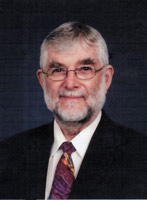 |
We are very grateful to Peter for his thorough review and selection for Peter's Picks. Peter was born in England in 1935 and came to live in the United States in 1968. He worked for the Eastman Kodak Company for 34 years, retiring in 1998. During his employment and continuing into retirement, he has been an enthusiastic photographer. His photography has won him numerous awards throughout Kodak and in International Salons, including 5 George Eastman Medals, which is the top honor awarded to the most outstanding picture in the Annual Kodak International Salon. He has served as a judge in both local and international photographic competitions for the past 20 years, and is a Past president of the Kodak Camera Club and past chairman of many of the Kodak Camera Club organizations. In the past five years or so, he has devoted his photographic skills and interest into nature photography, notably bird photography. His bird photography has been the subject of several one-person exhibits, the most recent being at Ding Darling NWR, in Sanibel, Florida, The Roger Tory Peterson Institute in Jamestown, New York, and at the Webster Public Library in Webster, NY. |
|
Gallery Picks of the Exhibit | |
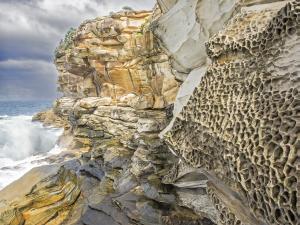 |
Bronte Beach – Australia
Sherman Henzel has produced a very unique, intriguing and beautiful
image in his photograph entitled Bronte Beach.
High quality landscapes usually have three basic compositional areas.
These photographs are often broken done by about 30% foreground, 45%
middle ground, and 25% background. When arranged horizontally these
areas often blend quite harmoniously.
Sherman has very successfully violated
the usual landscape pattern by using a foreground which is about 85% of
his landscape and reaches from the bottom to the top of his print. The
result is a beautifully creative landscape that emphasizes the very
interesting, intricate and unique patterns of the warm cliffs while
linking their location to the ocean and it’s crashing waves. Sometimes, it is effective to break the guidelines in order to produce a really great image. When a photographer does so the chance of success is very, very low. However, in rare instances a real photographic gem can be produced. Sherman Henzel’s Bronte Beach is one of those gems.
|
|
|
Staircase Abstract -- Ljubljana,
Slovenia
Joel Krenis’s dramatic abstract image
seems to jump powerfully off its photographic paper. He creates great
contrast in capturing the red, white, and black colors of this spiral
staircase. By using a down the staircase viewpoint, white and black
circular lines are dramatically stitched together with the needle like
red posts of the staircase's railing. Note how carefully Joel has placed
and pointed his camera so that the black and white circular patterns
spiral together just to the left and very slightly below the middle of
the image. The darkness of the black curl encircling the entwined
pattern also lowers the center of gravity of the entwined black and
white curl. The evenly spaced red posts lean into and intersect the
entwined black and white spiraling patterns. These relationships are not
easy to accomplish! Joel has very carefully and superbly composed this image. The use of a vertical composition further adds impact to the image. The three dominant colors, like odd number subject matter combinations, add to the balance in this superb photograph. |
Image City Photography Gallery ♦ 722 University Avenue ♦ Rochester, NY 14607 ♦ 585.271.2540
In the heart of ARTWalk in the Neighborhood of the Arts
creating a satisfying exhibition and learning experience for photographers and the art loving community